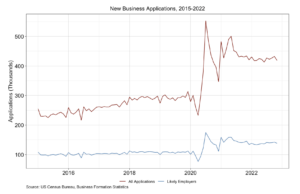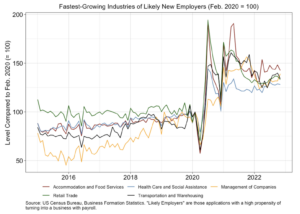
IN BRIEF: Entrepreneurship Since the COVID-19 Pandemic

Editor’s note: The Aspen Economic Strategy Group is pleased to welcome Luke Pardue, an economist at the payroll and HR platform Gusto, as an AESG Fellow. Luke obtained his PhD in economics from the University of Maryland and previously worked at the Federal Reserve Board and the US Census Bureau. As an AESG Fellow, Pardue will highlight trends shaping the US economy and discuss their relevance to economic policy in a monthly series called IN BRIEF.
IN BRIEF
For nearly four decades, the US economy has experienced a decline in business dynamism, as measured by business startup rates, closure rates, and the movement of workers between firms. In the early stages of the COVID-19 pandemic, however, there was a sharp uptick in new business formation. This measure of entrepreneurial activity remains elevated today, suggesting that pandemic-induced disruptions have sparked a longer-lasting surge in business dynamism. Such a reversal of decades-long trends could lead to increased innovation, faster growth, and a more resilient economy.
WHAT TO KNOW
- In 2020, there were 4.4 million applications for new businesses in the United States, nearly one million more than the 3.5 million applications in 2019. The pace of entrepreneurship accelerated further in 2021, when 5.4 million new businesses were formed, and remained elevated last year, with 5.0 million business applications, according to data released by the US Census Bureau this week.
- This jump has occurred not only among businesses without employees (“Sole Proprietorships”), but also among firms with a high propensity to hire additional employees (“Likely Employers”). The growth in applications among likely employers represents a shift in economic activity away from older, larger firms towards younger, smaller businesses – reversing a decades-long decline in the prevalence of such startups.

- New employer businesses have been forming most quickly in industries severely disrupted by the COVID-19 pandemic. Looking at the five fastest-growing industries compared to their February 2020 levels, applications have risen most quickly in Accommodations and Food Services (+41% in that time), Retail Trade (+30%), Transportation & Warehousing (+24%), Health Care and Social Assistance (+28%), and Construction (+17%). The growth in these industries indicates that entrepreneurs are responding to these disruptions with new innovations — meeting consumers’ needs while creating additional jobs at the same time.

- There are also early signs that this sharp rise in entrepreneurship will continue beyond the short term. In 2020, 35% of new business owners started a firm because they were laid off from their job; in 2021, the top reason shifted to these owners were seizing new pandemic-related opportunities. This change represents a movement from what scholars call “subsistence entrepreneurship” to the much more sustainable, longer-lasting “transformational entrepreneurship.”
- This surge in new business formation has long-term implications for the US economy. As Ufuk Ackigit and Sina T. Ates point out in their chapter of AESG’s latest policy volume, the long-term decline in the prevalence of younger, smaller firms in the US has been accompanied by reduced innovation and slower economic growth. This return of dynamism we are seeing in the growth of startups could signal the return of a more competitive economy, leading to greater innovation, higher productivity, and faster economic growth.
THE BOTTOM LINE
Prior to the pandemic, entrepreneurship had been on the decline in the US for decades, and the economy was increasingly dominated by older, larger firms. Today, levels of new business creation remain nearly 50% above their pre-pandemic levels, as entrepreneurs respond to COVID-induced disruptions. Creating an economic environment that continues to foster entrepreneurship well after the pandemic is key to building a more competitive, faster-growing economy.